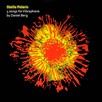
Intermezzo
Composer: Christopher Swist
Instrument: Vibraphone
Level: Intermediate
Published: 2009
Price: €15.00
Item details
-
Description +
-
Duration: 5 min.
An instrumental intermezzo is typically a smaller piece that will fit well in between larger works. That was always the impression this composition seemed to convey. It serves nicely as a momen-tary breath of air on a recital program.
The feel of the performance should be gentle and improvisatory, allowing the chords and gestures to speak naturally. As with some of my works, the performer is welcome to develop the harmony and form through improvisation once the score is well under hand.
This piece was written in 1998 and premiered by the composer in Connecticut on April 25, 1999.
-
-
Instrumentation +
-
Vibraphone
-
-
Watch+
-
Performance by Christopher Swist
-
-
About the composer +
-
Christopher Swist spends equal time as a percussionist, composer, engineer, writer, and educator. His music education started at age 6 with Buffalo Philharmonic percussionist John Rowland and continued through multiple degrees in performance and composition from SUNY-Buffalo (Jan Williams) and The Hartt School (Ben Toth and Al Lepak). He culminated his unique compositional voice, performance practice, and recording engineering into 2 solo albums: Whitewater of 2001 and Duality of 2013. His third solo album, Equal Simplicity, is being released in 2025.
Christopher’s varied catalog of orchestral, concerti, percussion, chamber and electronic music is published with Alfred Music, Studio 4 Music, Keyboard Percussion Publications, Edition Svitzer, and Bachovich Music. Swist’s latest work is a Double Concerto for Vibraphone and Marimba that he also performs as the vibraphone soloist. His music has been performed by the Grand Rapids Symphony, Hartford Symphony Orchestra, The Louisville Orchestra, American Modern Ensemble, Grupo PIAP, YoungArts, and the United States Military Academy. He also presents recitals as a performer/composer who plays both acoustic and electronic music.
Christopher is a symphonic musician as well, performing in the percussion sections of symphony orchestras in Hartford, New Haven, Springfield, Waterbury, Bridgeport, Ridgefield, and Norwalk. He has been the principal percussionist of the New Britain Symphony Orchestra since 1999 and directs the NBSO’s educational outreach programs and steel pan/percussion fusion ensembles.
Professor Swist is an educator, pedagogue, and administrator. He is Director of Recording Arts at Trinity College in Hartford. He also designed and built EvenFall Studio LLCin New Hampshire, and, is a pro audio writer/reviewer for SonicScoop. Christopher was recently inducted into the Buffalo Music Hall of Fame.
-
-
Reviews +
-
Review (Percussive Notes, March (58) 2012)
Standing in contrast to many grooveoriented or atonal mallet solos, this aptly titled work will serve as a nice breather for audience members. Throughout the five-minute piece, Christopher Swist creates a musical atmosphere reminiscent of piano works by Satie or Debussy as notes are carefully chosen to exploit the sonic characteristics of the instrument. Additionally, appropriate pedalingserves to highlight the composer’s clever usage of melodic sequencing and intriguing chord patterns.Labeled at no faster than quarter = 86, the music alternates between sections of rubato and a tempo without feeling disjunct. Melodic gestures seamlessly shift between major chords, minor chords, and seventh chords with ease and intelligence. In the hands of a vibraphonist with a mature (or developing) sense of musicality and pacing, this solo will serve as a welcome addition to any master class, recital, or concert.
—Joshua D. Smith
-
-
Credits +
-
Front cover graphics and layout: Ronni Kot Wenzell
Photo: Christopher Swist
Printed in Copenhagen, Denmark
Copyright © Edition Svitzer
www.editionsvitzer.com
-



